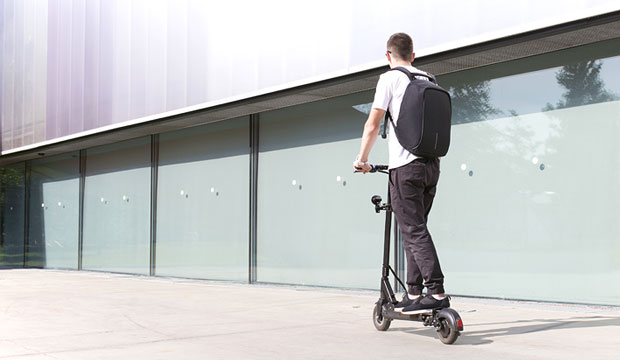As summer winds die down, here’s hoping one of the season’s most ridiculous and unnecessary fads goes with them.
Bird and Lime e-scooters — the vehicles for the two rival companies’ Mobility as a Service scheme — are just the latest twist on the foot-powered Razor Scooters that took America by storm in 2000.
Unlike Razor, which introduced electric-power models back in 2003, Bird and Lime utilize a subscription model instead of ownership.
Bird, Lime, and another competitor, Spin, have similar business strategies — namely to provide simple, cheap transportation for the”last mile” — whether that means from a parking lot on the edge of a downtown district or from a subway or another mass transit stop — to the final destination.
The concept is similar to bike share programs that allow users essentially to rent equipment for a short trip. However, in the case of scooters, there are no central docking stations.
Moreover, the companies have introduced their respective scooters in various cities around the country without considering infrastructure, and currently, there are no designated drop-off points. Instead, the scooters seemingly are “abandoned” around urban areas.
Apparently, this is exactly what the companies had in mind. The idea was that those curious individuals who stumbled upon one would try it out and, in the process, create a buzz that could turn these scooters into the next big thing.
The venture capital funding the companies have attracted, combined, so far has exceeded US$250 million. Clearly, someone believes scooters could be the future.
I hope they are wrong!
Been There
Bird, Lime, and Spin are hardly the first to think of MaaS as a solution to crowded roads, lack of parking, and poor mass transit.
By providing a reasonably affordable way for individuals to get from point A to point B, Uber, and Lyft have showcased that fleets of taxis aren’t necessary for mid-sized cities. Moreover, consider the vast amounts of dollars being spent on autonomous vehicle development.
Clearly, there is a recognition that not everyone wants to drive or own a car. However, scooters aren’t the solution — at least not for America.
The original push scooters were little more than wheels attached to boards. They typically were used only by children — in part due to the cobblestone roads of the era, which made riding precarious at best!
The first successful motorized scooter was the Italian-made Vespa, which was introduced in the aftermath of World War II. At the time, Italy’s economy was ruined. As the country struggled to recover from the war, few people could afford cars.
Unlike motorcycles, scooters were something that women, as well as men, could ride to work, school, and the market. Vespa and various competitor models spread throughout Europe.
At the same time, Americans were moving to the suburbs and buying cars. Had it not been for the 1952 film Roman Holiday, which featured Audrey Hepburn and Gregory Peck riding a Vespa, those scooters might have gone unnoticed in the United States.
Done That
Fast forward to 2001, when inventor Dean Kamen rolled out the SegwayPT — a device that Steve Jobs reportedly expected to be as big a deal as the PC. John Doerr, the venture capitalist behind Netscape and Amazon, proclaimed it would be bigger than the Internet.
There were even proclamations that cities might be retrofitted, as Segways could alleviate congestion on the roads and be an alternative to cars.
Some of that probably sounds familiar, even if the Segway doesn’t ring a bell immediately.
For those who don’t have Segway memories, it is a two-wheel platform with a handle. Instead of spurring a transformation in cities, it largely has been relegated to tourist destinations. Occasionally it is used by police officers in urban areas.
Segways, much like today’s Bird and Lime scooters, have a fundamental flaw: They lack the required infrastructure to make them practical.
Sidewalks — especially in the crowded urban centers of New York, Philadelphia, Boston, Chicago, San Francisco, and cities — aren’t ideal for a motorized vehicle that moves at a speed far faster than people can walk.
The Segway PT has a maximum speed of 12.5 miles per hour, which is just under a 5-minute mile! The new e-scooters from Bird, Lime, and Spin can carry an adult weighing up to 200 pounds at a maximum speed of 15 mph. At that speed, an accident involving a pedestrian and arider could be serious — even fatal.
There have been suggestions that perhaps these devices should be relegated to the bike lanes in cities, but that raises another issue. Shouldn’t the bike lanes be for bicycles?
The Cyclist View
As an avid cyclist, I am the sort of rider who has spent a not-so-small fortune on bicycles. I wear a cycling kit, including shorts, and jersey, a helmet, and gloves. I don’t just look the part when I ride, however — I know the rules of the road.
Most states and many communities have laws against adults riding on the sidewalk, especially at high speeds –which is taken to be anything over 10 mph.
As a cyclist, I am used to sharing the road with cars, even if the cars aren’t always eager to share them with me. So maybe I’m a bit smug or even self-righteous, but in the few cases so far where I’ve seen e-scooters in the bike lanes, it hasn’t made me happy.
First and foremost, as someone used to dealing with cars, I’m very aware of my surroundings when I’m on my bicycle. However, many of the drivers of e-scooters I’ve observed have seemed almost oblivious to the world around them — as if mobility gave them the right to tune out.
Second, I’m prepared for a crash or accident with gloves and a helmet. Those riding on e-scooters are not.
Finally, bike lanes are far from ideal, even for bikes. Too often, they’re strewn with broken glass and debris. They have way too many potholes and large cracks. A bicycle has large wheels and tires that can navigate obstacles.
Accidents Will Happen
To date, it is unclear how many accidents there have been involving e-scooters, but sadly, at least one individual has already been killed already in an accident involving one. A 24-year-old man was killed this past week in Dallas after he fell while riding an e-scooter home, The Washington Post reported.
Although this is the first reported death, more accidents are waiting to happen. Several media outlets reported that a woman was spotted on an e-scooter on I-77 in Charlotte, North Carolina!
Bicycles and mopeds are prohibited on Interstates, of course — with the exception of some rural parts of New Mexico –and it should be obvious that e-scooters would fall into that category. However, given the influx of these devices, we shouldn’t be surprised to see these in places not deemed appropriate or even legal.
At the City Level
The legal issues certainly will be resolved as cities across the country are faced with how to regulate the use of e-scooters and enforce the new rules.
The Los Angeles City Council this week voted 13-0 to approve a new set of rules for dockless e-scooters, along with a citywide cap of 3,000 e-scooters in total.
That number could be increased if the companies agree to operate in disadvantaged communities. In addition, all the companies will be required to carry $5 million commercial general liability insurance.
Other cities have made it clear that e-scooters aren’t welcome. Beverly Hills and West Hollywood have voted to ban them, and other communities across the country have instituted their own rules.
Perhaps some communities see a potential revenue stream from thee-scooters via parking tickets. The Indianapolis City Council this summer approved a $25 fine for scooters parked in doorways, alleys, handicapped spots, bus stops, and even rain gardens.
The University of Texas in Austin recently announced that it will impose a $150 fine for improperly parked e-scooters on campus. While the fines will be addressed to the companies, there is speculation that those fines could be passed down to the last user. Ase-scooters do rely on GPS, it would be easy enough to determine who left the scooter where and when.
Understanding the Infrastructure Issue
Companies such as Bird, Lime, and Spin — and others that are bound to pop up — need to understand that America’s infrastructure isn’t designed for e-scooters. Bike lanes aren’t meant to be catchalls, and sidewalks are not ideal either.
The Vespa didn’t catch on in America because Americans could afford cars in the 1950s and 1960s, and the Segway didn’t catch on in 2001 because inner cities were already retrofitted to adapt to cars. The suburbs were made possible by car ownership!
Of course, it may not always be this way. The thing to remember is that human cities have been around literally for eons. Damascus, Syria — widely believed to be the oldest continuously inhabited city in the world — dates back at least 11,000 years.
That city certainly was retrofitted many times for the transportation of the era, from horse-drawn carts to railroads and cars.
In those 11,000 years of human cities, cars have been around only for 150 years. In most cities, they have been plentiful and common for less than 100 years. Even after World War I, horse-drawn wagons were common in New York and certainly across Europe.
Much attention has been given to the progress of bicycles in cities such as Amsterdam and Copenhagen, but that is largely because those cities never were all that car-friendly in the first place, and bicycle use evolved side-by-side with the car. That hasn’t happened in America, and in fact, barely has happened even in other parts of Europe.
Cities where Vespa-style scooters remain popular — Naples, Rome, Florence, Barcelona, and Lisbon, among others — have mild weather, small city centers where people often don’t live in far-flung suburbs, and roads that aren’t ideal for cars. That is why the motorized scooters became, and remained, popular — not because the scooter replaced the car.
American inventors and proponents of MaaS need to look at what makes Uber and Lyft popular in the cities and suburbs alike. It provides a quick, affordable ride.
E-scooters are a novelty. They threaten to crowd sidewalks, bike lanes, and roads alike, and people could get hurt or even killed in the process. Before anyone else dies, the e-scooter should sputter and die instead.























































